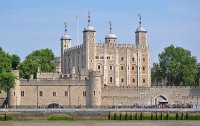The Tower of London is an iconic medieval fortress located in the central part of London, England, along the River Thames. It has a rich history and is renowned for its distinctive architectural features. Let's discuss the architecture of the Tower of London:
White Tower: The White Tower is the central structure within the Tower of London complex. It was built by William the Conqueror in the 11th century and stands as the oldest part of the fortress. The tower is made of white limestone, which gives it its name. It has four turrets at the corners and a square layout, measuring approximately 36 by 32 meters. The walls are about 4 meters thick at the base and taper towards the top.
Inner and Outer Ward: The Tower of London is surrounded by two concentric rings of defensive walls, known as the Inner and Outer Ward. The Inner Ward, encircling the White Tower, contains various buildings and structures such as the Medieval Palace, the Chapel of St. John, the Wakefield Tower, and the Bloody Tower. The Outer Ward is the larger area surrounding the Inner Ward and contains additional buildings, such as the Jewel House and the famous Traitor's Gate.
Defensive Walls and Towers: The Tower of London features several defensive walls and towers that were added over the centuries to strengthen its fortifications. These walls were constructed using layers of stone and are equipped with battlements, arrow loops, and defensive gateways. Some notable towers include the Beauchamp Tower, the Bell Tower, the Salt Tower, and the Lanthorn Tower. These towers served various purposes, including accommodation for prisoners, storage, and defense.
Tower Bridge: While not a part of the original Tower of London architecture, the Tower Bridge has become closely associated with the fortress. It is a suspension bridge built in the late 19th century and spans the River Thames adjacent to the Tower of London. The bridge features two towers with a bascule bridge in the center, allowing ships to pass beneath. The architectural style of the Tower Bridge complements the historic character of the Tower of London.
Expansion and Modifications: Over the centuries, the Tower of London has undergone various expansions and modifications. Additional buildings, such as the Medieval Palace and the Victorian Waterloo Barracks, were constructed within the fortress walls. The purpose of these expansions ranged from providing accommodation to enhancing the fortress's defensive capabilities. These additions have contributed to the complex architectural history of the Tower of London.
Overall, the architecture of the Tower of London represents a blend of Norman, medieval, and later additions. Its distinctive white tower, defensive walls, towers, and surrounding structures combine to create a fascinating and imposing architectural ensemble, reflecting its historical significance as a royal palace, prison, and stronghold throughout the ages.
